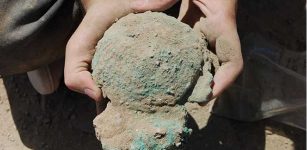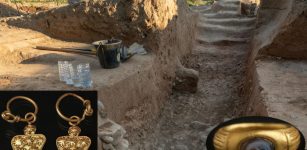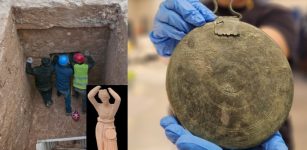Melipona Beecheii – Sacred Ancient Maya Beekeeping Site Discovered In Quintana Roo, Mexico
Conny Waters - AncientPages.com - Bees are among the most recognized insects, celebrated in ancient myths and folklore across various cultures worldwide. These important creatures have been integral companions to humanity since the dawn of civilization. Often lauded as one of the 'most hard-working' animals, bees are renowned not only for collecting pollen and producing honey but also for their vital role in pollination and maintaining ecological balance.
The Maya, both in contemporary times and during the precolonial era, have practiced the cultivation of the Melipona beecheii, a species of stingless bee known in the Mayan language as xunán kab. This traditional practice highlights the deep connection between the Maya people and their natural environment, as well as their extensive knowledge of apiculture and the importance of these pollinators in their agricultural systems. Credit: Government of Mexico
Beekeeping has been a longstanding tradition among the Mayan population of the Yucatan Peninsula, dating back to pre-Hispanic times. Ancient codices, such as the Madrid and the Tro-Cortesiano, and chronicles from the Indies, reveal that indigenous people utilized honey as a food source, a commodity for barter, and in ceremonial practices. This deep-rooted connection between bees and human societies highlights their enduring significance throughout history.
The recent announcement by archaeologists from the National Institute of Anthropology and History (INAH) regarding the discovery of ancient Maya beekeeping tools is a significant development in our understanding of Mayan culture and practices. The cache, found during construction work on a section of the Maya Train in Quintana Roo, includes three limestone jobón lids, along with other artifacts related to daily Mayan life.
This discovery lends credence to the theory that ancient Maya beekeeping and honey production were not limited to the northern part of modern-day Quintana Roo, as previously known, but were also practiced in the southern region.
According to INAH, this finding supports what some chroniclers, such as Gonzalo Fernández de Oviedo y Valdés, observed in the territories that today make up the south of Quintana Roo, which raises the hypothesis that Mayan Melipona culture spread to this area of the state.
Bees were sacred in Mesoamerica. Credit: Adobe Stock - Matrioshka
The jobón lids, also known as panuchos, are round and measure between 20 and 25 centimeters in length. Based on their characteristics, these artifacts are believed to belong to the Mayan Postclassic Period (A.D. 950–1539), a time when the Yucatan Peninsula was a central hub for Melipona honey production.
“Only one of the lids is in a good state of conservation,” Carlos Fidel Martínez said in a statement published by INAH, but “the other two [lids] have a high degree of erosion.”
The unearthing of these beekeeping tools provides valuable insights into the agricultural practices and economic activities of the ancient Maya civilization. It highlights the importance of apiculture and honey production in their daily lives and underscores their advanced knowledge and expertise.
The jobón, a hollow log housing an active hive of melipona bees, is a traditional Maya beekeeping practice that continues to be used by Indigenous Maya communities on the Yucatán Peninsula. In contemporary Maya beekeeping, lids similar to those discovered by INAH (National Institute of Anthropology and History) are still employed to seal the opening of a jobón.
Melipona Beecheii - Sacred Mayan Bee
According to archaeologist Rafael Martínez, the excavators initially mistook their discovery for a wall. However, upon finding the lids, they realized they had uncovered the remnants of a meliponary, an apiary dedicated to cultivating Melipona beecheii, known as the "sacred bee" to the ancient Maya.
Mayan ruins in Tulum, Quintana Roo, Mexico. Credit: Adobe Stock - Wasim
The melipona bee, also known as the "Mayan sacred bee," is a stingless species that the Mayan people have cultivated for centuries. This bee holds great significance in Mayan culture due to the healing properties of its honey, prompting the Mayans to hold four to six ceremonies annually in honor of these remarkable insects during pre-Hispanic times.
Unlike other bee species, the melipona bee does not have a stinger. Instead, it defends its colony by "biting" any perceived threat, often sacrificing its life in the process. This bee produces a variety of valuable products, including honey, wax, pollen, and propolis, in addition to its crucial role as a pollinator.
While a melipona hive produces a relatively small amount of honey (approximately 1.5 liters per year) compared to European bee colonies (up to 30 liters annually), the honey from melipona bees is highly prized for its medicinal properties. It is known to boost the immune system and is used to treat ailments, wounds, burns, and diseases. Furthermore, melipona honey is highly valued in the cosmetic industry for creating soaps, creams, and powders.
INAH archaeologists found three limestone jobón lids that offer evidence of beekeeping activity. Credit: INAH
Notably, the pollen produced by melipona bees has a protein value 50% higher than that of other bee species. These stingless bees are also crucial pollinators for various crops, including annatto, avocado, coffee, pumpkin, chayote, habanero chili, mango, cucumber, watermelon, and tomato, among others.
In addition to the lids, archaeologists unearthed other artifacts made of ceramics, stone, and flint, including a cajete, or vase, with red and orange decorations. They also found two limestone metates that are 40 centimeters and 50 centimeters long, an ax, a hammer, and a star-shaped shell bead.
The area where archaeologists found the beekeeping tools and the other artifacts is referred to by INAH as Frente 5, archaeologist Raquel Liliana Hernández Estrada said — an area inhabited by ancient Maya communities that did not belong to the elite.
See also: More Archaeology News
“Most likely, we are in the presence of housing complexes from cities peripheral to ceremonial sites such as the Chacchoben Archaeological Zone and the Los Limones site,” Hernández said.
Since the construction of the Maya Train began in 2021, archaeologists have remarked that the discoveries made along the route could be considered Mexico’s “greatest archaeological treasure” in recent decades.
Written by Conny Waters - AncientPages.com Staff Writer
























